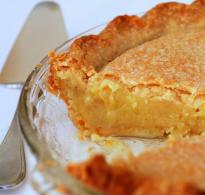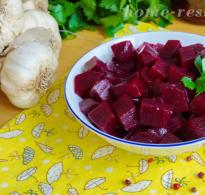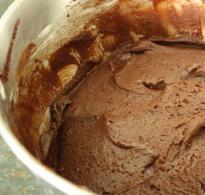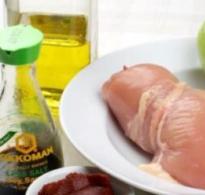Canning - history and methods. Means and methods of preservation
Today it is not possible to name all available methods of food processing different types for them long-term storage. Microflora can be destroyed in different ways, leaving the product suitable for human consumption only.
There are different ways of preserving food different nationalities, peoples, in addition, they differ depending on personal preferences and the products themselves. Every housewife has secret ingredients(marinades and spices), which are added to a jar of cucumbers or tomatoes before storing them. However, with all the arsenal of canning methods, they can be divided into main groups, which we will discuss in more detail.
Types of Canned Food
Various canning methods are designed to remove moisture; as a result of this process, a beneficial environment for the growth of bacteria is destroyed, and products can become more long term storage or be filled with microbes, but still remain edible for humans. Let's look at each of them known methods.
- Drying. The method is used for some types of vegetables, fruits, fish or meat. The essence of the method is that a special drying apparatus or the sun's rays manage to remove moisture from the food before bacteria begin their attack.
- Salting. Products, often meat or fish, are generously rubbed with salt, which removes liquid, depriving bacteria of their usual habitat.
- Pickling. As a result of this method, products are saturated with vinegar, lactic or citric acid. These substances are harmless to humans in small concentrations, but bacteria cannot multiply in them.
- Fermentation. This type of canning is used mainly for dairy products, sometimes for some vegetables. The principle of operation is similar to the previous method, only canned products are saturated with special bacteria - lactic acid bacteria, which process the sugars contained in the product.
- Sugaring. The method also has an industrial name - canding (derived from English word candy – sweet/candy). A large amount of sugar added to the product removes moisture from it and kills bacteria. A striking example of candiing is candied fruit.
- Smoking. Bacteria in the product are destroyed during treatment with fire smoke. A huge advantage of this method is the delicious aroma of the finished product.
- Sterilization. Products are subjected to intense heat, which kills bacteria. If you heat food several times in a row, you can destroy spores - they are a more stable form of microbial existence.
- Sealing. The method follows immediately after warming up. This tandem prevents the proliferation of bacteria that require oxygen to survive.
It should be said that today canned foods those that are hermetically sealed can also be considered. Of course, before finding reliable “clothes”, they can be processed using various methods, which will certainly affect appearance product and its taste.
It’s up to each person what to choose when planning a diet, but remember that canned food, even expensive and high quality, cannot be considered natural product, so use them infrequently and for short periods of time.
Interest in canning at home never subsides. Even despite the fact that there has long been no need to stock up on food for future use. Today, in any store you can buy any dish you want. And the point is that preparations for the winter are independent dishes, and their taste qualities eclipse original product. There is only the main question. How to preserve vegetables and fruits until winter and at the same time enriched with vitamins and microelements?
There are many ways to prepare food for the winter. One of the most common canning methods- This is preservation with sugar. If the fruits are boiled in large quantities sugar, the result is a product with a high sugar concentration - more than 60%. As a result, microbes do not reproduce and die. This type of canning includes: jam, preserves, jelly, etc.
Second canning method- This is marinating. When pickling, acetic acid acts as a preservative. It is capable of suppressing the activity of microorganisms. Very often, acetic acid is added to the marinade mixture, which also includes table salt, sugar and all kinds of spices. Fragrant spices Give prepared marinades a specific taste and aroma. Therefore, cucumbers, mushrooms, tomatoes, cabbage eggplants for the winter They have extraordinary taste and can be stored in a cellar or on a shelf for a long time.
Canning at high temperatures. Naturally, high temperature kills most microbial cells. The products are processed at high temperatures, thereby eliminating the possibility of further entry of harmful microorganisms. Be sure to seal the container hermetically. There are two ways of such canning: pasteurization and sterilization.
Pasteurization is heating the product just below one hundred degrees (for example, 95°, 90°, 80°), and sterilization is heating above one hundred degrees, but this method is only possible in special factories.
Sterilization of products is more effective way canning. Products canned in this way may stand long time and at the same time not lose your qualities.
Home canned food under the influence high temperature carried out this way. Prepared products are placed in clean glass containers. It should be placed in a container with warm water. The water must be heated to a certain temperature and the product must be kept for a certain time specified in the recipe.
Another canning method- This is drying, that is, removing moisture from mushrooms and vegetables. You should know that moisture must be removed completely, since otherwise the microbes will continue to function. Dried products must be stored exclusively in hermetically sealed containers.
Freezing is a method in which prepared products are frozen at a temperature of -20°C and below and stored only in this form. Before use, food should be defrosted for 4 hours at room temperature. Do not defrost food in water, as it will lose its nutrients and the taste quality deteriorates significantly. Fast-frozen food cooks twice as fast as fresh food.
Some other great ways of preserving are soaking, pickling and pickling. The preservative is lactic acid, which is formed as a result of fermentation. Cabbage, beets, watermelons, apples and cucumbers are most often prepared in this way.
But whichever preservation method you wouldn’t choose, you won’t find better homemade preparations for the winter in any store.
Rating 5 points Views: 1095Canning is a process that extends the shelf life of foods in a condition that makes them suitable for consumption.
There are several types of canning:
1. Drying– one of the oldest methods of canning. During the drying process, moisture almost completely evaporates from products, which is a favorable environment for the development of microorganisms. The habitat of microbes is lost, and therefore the microbes themselves, which are the main culprits of food spoilage, disappear.
2. Pickling– processing foods with table salt. Soaked saline solution, the food becomes an unattractive dish for bacteria.
3. Marinating– processing various products organic acids that destroy bacteria. These include citric, acetic, lactic and other acids, which create an environment unfavorable for the development and growth of microorganisms.
4. Pickling is a combination of two types of canning: pickling with organic acids and salting.
5. Candiing - sugaring. This type of canning is most often used when preparing fruits and berries. Products soaked sugar syrup, dry out, and the syrup itself crystallizes. This prevents bacteria from developing and spoiling the product.
6. Gelation- This is the processing of products, as a result of which they turn into a gelled mass. Gelation occurs under the influence of starch, pectin or gelatin. After the mass thickens, it becomes impenetrable to bacteria and other microorganisms.
7. Drying– a combination of dehydration of the product and its chemical preservation with table salt.
8. Jam– obtaining canned fruit by boiling products in sugar syrup.
9. Sealing– isolation of the product from oxygen, due to which bacteria die.
10. Pasteurization– prolonged heating of the product to a temperature of 60-70ºС. This procedure contributes to the death of most microorganisms contained in the product. However, microbial spores survive, and to prevent them from developing, the pasteurized product should be stored in the refrigerator.
11. Sterilization– boiling the product for a certain time, due to which both microbes and their spores die.
12. Freezing– processing of products at low temperatures, during which the activity of bacteria completely stops.
Under canning It is generally accepted to understand a method of food preservation (manufacturing canned food), which involves the technical processing of fresh raw materials in order to inhibit the vital activity of microorganisms that provoke its spoilage. In addition, canning also includes a number of other methods that increase the shelf life of food.
Chemical methods of preservation
Among chemical methods canning used in food industry, canning with table salt, or salting, is of greatest importance. In addition, from chemicals For canning, acetic acid, antiseptics, antioxidants, spices, and gases are used.
Ambassador. The preservative properties of table salt solutions are due to the effect of sodium chloride on proteins, enzymes and microorganisms. When acting on proteins, Na + and C1 - ions, joining at the site of peptide bonds, block them, while protein molecules become resistant to the action of proteolytic enzymes. This effect is directly dependent on the concentration of table salt in the cell sap.
Table salt inhibits and changes the nature of the biochemical activity of enzymes. In this regard, proteolytic enzymes of microorganisms in the presence of salt form different protein breakdown products than in its absence. High salt concentrations inhibit the biochemical activity of proteolytic enzymes. The vital activity of microorganisms is accompanied by osmotic exchange between the cell and the environment. When the osmotic pressure of the solution surrounding the microbial cell is greater than the osmotic pressure of the plasma, an outflow of water from the plasma occurs (plasmolysis), as a result of which normal metabolism in the microbial cell is disrupted.
Use of acetic acid. Preservation of fish is achieved by the combined action of weak solutions of table salt (6-18%) and acetic acid (0.3-2%). Acetic acid enhances the preservative effect of table salt, and table salt weakens the maceration of meat with acetic acid. The preservative effect of acetic acid is due to changes in the concentration of hydrogen ions and the toxic effect of undissociated molecules. For the life activity of the vast majority of microorganisms, the optimal pH values lie in the range of 6.5-7.5, so a decrease in pH to 4.5-5.0 causes the death of such microorganisms. However, there are types of microorganisms that can develop even at a pH of 2.5-4.0.
Solutions containing 1-2% acetic acid inhibit the development of most putrefactive microorganisms, and at 5-6% concentration almost all microbes die off, but the spores remain viable. Mold resistant to acetic acid solutions: weak solutions stimulate mold growth, and some types of molds grow in solutions containing even 10% acetic acid. Mold use acetic acid as a source of carbon, which leads to a decrease in acid concentration and provides the opportunity for the development of other types of microorganisms. The development of mold on the surface of marinades can be prevented by covering them with a layer vegetable oil(contact with air is excluded), as well as the use of hermetic packaging
Use of antiseptics. A number of chemical substances have the ability to react with the protoplasm of a microbial cell and thus have a toxic effect: they paralyze the action of enzymes and cause the death of microbes; spores are more resistant to such action. Such substances are called antiseptics. The preservative effect of an antiseptic depends on its chemical nature, concentration, temperature conditions, pH of the environment. When the antiseptic concentration is below the lethal level, inhibition occurs, and at low concentrations it even stimulates the growth of microorganisms. An increase in temperature increases the toxicity of the antiseptic. However, if its concentration is insignificant, then when the temperature rises, the protective effect of the antiseptic may be insufficient to protect products from spoilage. Antiseptics have a selective effect, so the preservative effect of individual antiseptics depends on both the species composition of the microflora and the number of microorganisms.
For making food products It is allowed to use methenamine, benzoic acid and its sodium salt (sodium benzoate), sorbic acid.
The use of antioxidants. Fat oxidation is a very significant defect that occurs during storage of frozen, salted, dried fish, fishmeal. The oxidation of unsaturated fatty acids that make up lipids is caused by the action of atmospheric oxygen and oxidizing enzymes (lipoxidases).
Oxidation can be delayed by the use of antioxidants, the action of which is determined by the presence of labile hydrogen atoms in their molecule; therefore, when peroxides are formed, the antioxidant absorbs energy and stops the autoxidation reaction. The antioxidant effect is achieved both through the destruction of active peroxides and through the inactivation of oxidants contained in the product. The protective effect of the antioxidant continues until it is completely oxidized, after which the process of oxidation of the substrate (fat) continues.
Chemicals that stimulate the action of antioxidants, but do not have an antioxidant effect, are called synergents (citric acid).
Use of spices. In the production of delicatessen lightly salted fish products with the addition of spices, the preservative effect of salt is somewhat enhanced due to the action of the essential oils contained in the spicy substances. The toxic effects of essential oils vary: the most toxic are allyl isothiocyanate (from mustard), eugenol (from cloves), and cinnamaldehyde (cinnamon). For example, essential oil mustard at a concentration of 0.2% is equivalent in bactericidal effect to 0.031% sulfur dioxide.
Gas storage. Changing the composition of the air surrounding the product has a significant impact on the vital activity of microflora. An increase in CO 2 content in the air inhibits development aerobic microorganisms, but does not affect the development of anaerobes. When the air contains 10-20% CO 2, the growth rate different types microorganisms are reduced by 20-50%. The cessation of vital activity of molds and bacteria occurs when the air contains 40-50% CO2, however, the product acquires unpleasant organoleptic properties.
The activity of molds and microorganisms is actively inhibited by ozone: at subzero temperatures, the presence of 0.0003-0.0005% ozone in the air effectively inhibits the growth of microorganisms, but the active oxidative properties of ozone negatively affect fatty foods, causing rapid oxidation fat
To suppress the vital activity of microflora, gaseous sulfur dioxide and nitrogen trichloride are also used. Sulfur dioxide is used for canning fruits and vegetables harvested as semi-finished products for subsequent processing, which ensures the destruction and removal of excess sulfur dioxide. IN fresh fruits and berries, the content of sulfur dioxide should not exceed 0.15-0.2%, and in finished products - 0.002-0.010%.
Methods home canning
To protect food products from spoilage, people long ago developed ways to preserve them (canning) by drying, smoking, salting and fermenting, pickling, and subsequently cooling and freezing, canning with sugar or using preservatives and heat treatment.
Let's take a look at these home canning methods.
From the book Cucumbers, tomatoes - 1 author Cooking Author unknown -Recipes for home canning using cucumbers - For pickling you need to take cucumbers late varieties, well ripened, but not overgrown. The best length of the fruit is 8-15 cm. Cucumbers are sorted before pickling, discarding sick, damaged and ugly ones. Then wash
From the book Homemade preparations (canning without salt and sugar) author Polivalina Lyubov AlexandrovnaContainers for canning Glass containers are usually used for canning fruits and vegetables at home. Individual products can be preserved in barrels or bottles, but in this case it is difficult to ensure tight sealing. To ensure that the products do not
From the book Home Canning author Andreeva Ekaterina Alekseevna From the book Home Canning. Salting. Smoking. Complete encyclopedia author Babkova Olga ViktorovnaTechnology, rules and techniques for home canning When starting canning, each housewife must strictly follow the technology for preparing a particular product, follow all given instructions regarding the preparation of fruits and containers, the method of processing and
From the book The Complete Encyclopedia of Home Canning. Live vitamins in winter author Krylova Elena AlekseevnaTechnology, rules and techniques for home canning When starting canning, each housewife must strictly follow the technology for preparing a particular product, follow all given instructions regarding the preparation of fruits and containers, the method of processing and
From the book Storage and Processing of Vegetables author Kozlova Valentina FilippovnaMICROBIOLOGICAL METHODS OF PRESERVATION As a result of fermentation of sugars lactic acid bacteria Lactic acid is formed, which is a natural preservative. Microbiological methods of preserving vegetables are based precisely on the use
From the book Canning for Lazy People author Kalinina AlinaBasic methods of food preservation There are several ways to preserve food: drying, salting, pickling, pickling, cooking with sugar, cooling, freezing, sterilization, etc. Drying is one of the long-known methods
From the book Dishes from Canned and Frozen Foods author collection of recipesContainers for canning Glass containers (jars) are usually used for canning fruits and vegetables at home. Individual products can be preserved in barrels and bottles, but in this case it is difficult to ensure tightness when sealing. Jars for
From the book Canning. 60 recipes you don't know yet author Savkova RaisaFrom the history of canning Since ancient times, humanity has struggled with how to extend the shelf life of food. The products were dried, dried, smoked and treated with natural preservatives: salt, sugar, olive oil, vinegar. The first canned food made by man was
From the book Canning. Big book of recipes author Mikhailova Irina AnatolyevnaTypes of canning Pasteurization One of the most advanced methods of canning is pasteurization. The fact is that during the heating process the temperature of the liquid does not reach 100°C and thanks to this, the main part of the vitamins and microelements in the products is preserved.
From the book Vegetable caviar and lecho. Cooking like professionals! author Serikova Galina AlekseevnaMethods of canning When canning at home, the following canning methods are most easily implemented and are preferentially used: 1. Sterilization. With this method of canning, microorganisms die and enzymes are destroyed in
From the book Russian Cuisine author Kovalev Nikolay IvanovichThe ABCs of Home Canning
From the book Great encyclopedia canning author Semikova Nadezhda Aleksandrovna From the book Preparations and pickles author Kizima Galina AlexandrovnaMethods for preserving and preserving the meat of wild animals Anyone who is interested in hunting needs to know how to preserve the caught game in fresh before cooking or canning and be able to prepare meat for long-term storage. First and necessary condition
From the author's bookMethods of preserving and preserving wild bird meat Birds caught during a hunt should be straightened and hung by the head until they cool, so bird carcasses are not placed in hunting bags, but hung from them. It is necessary to remove from the carcass as soon as possible using a finger or






